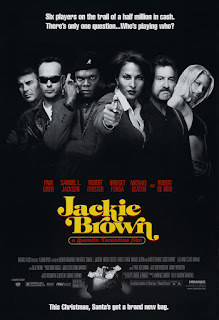The ability to rate films
on IMDb is liable to showcase the most diverse interests of any filmgoer. To
use myself, as an example, I think my phone is the only place that you could
find titles as diverse as Amadeus
next to Die Hard 2 or Taxi Driver in between Clue and The Rocky Horror Picture Show. It was as I scrolled through my
ratings one afternoon that I came across another curious line-up and suddenly
felt compelled to put fingers to keys and hammer out a few thoughts about
another film. You see, in my IMDb ratings, sandwiched in between Oliver Stone’s
The Doors (a controversial and trippy biopic of the seminal psychedelic
rock band starring Val Kilmer as the perfect Jim Morrison) and The House of the Long Shadows (an homage
to the old-dark-house thrillers of the ‘30s made in 1984 and starring the
triumvirate of Vincent Price, Christopher Lee, and Peter Cushing) there is The Sandlot. These three films have
nothing in common with each other (except each one I liked enough to give a
decent rating), but my eye was drawn to the poster of The Sandlot and I suddenly felt like saying something.
I’m not really a sports
person and I have never really been drawn to sports movies as the result. To
make a confession: I have never even seen Rocky
all the way through. Yet, I make an exception for The Sandlot: the story of a group of boys who play baseball and
“get into the biggest pickle any of them had ever seen.” Normally, as far as
pitches go (no pun intended), that wouldn’t really sell me on the movie. The Sandlot won me over though and, to
this day, the film holds a special place in my heart. Why? It is a question
that I endeavor to answer today.
*
I watched The Sandlot for the first time on an old
VHS copy which, if memory serves, we fished out of the attic for movie night.
The memories of that first viewing are not engrained in my mind as well as
other first-time movie experiences, but I do remember liking it from the
get-go. There was something so fun, light, and entertaining about this story
that you couldn’t help but have a good time watching it. The Sandlot became a staple for me on road-trips; a portable
VHS-playing TV situated in the backseat would keep me occupied for the trips’
long hours and soon, the film became a reliable standard for me. I recall when
I upgraded to a DVD copy on my
birthday and, ironically, it was then that the movie began to be played a
little bit less often in our house. Granted, this was around the time that I
really started to get into movies as a genuine art-form and, though The Sandlot is A LOT of fun, I don’t
think I can possibly categorize it alongside something like Citizen Kane (just to go for the
obvious/stereotypical example). But, that should not undermine the enjoyment
which the film brought me and still does. There are still times that the mood
will overtake me and I’ll be inclined to pop it in and enjoy.
And, one must assume,
that this same amount of enjoyment has been bought to countless others. The
freckled face of Hamilton “Ham” Porter can still be found on countless t-shirts
as text proclaims “You’re killing me Smalls” or - the insult of all insults –
“You play ball like a girl!” Both phrases have entered our lexicon; a testament
to the film’s longevity and its ability to entertain a myriad of viewers.
So, if I am not the only
one who has been won over by this film, then what is it doing so right?
I think the answer lies
in the film’s simplicity. As I mentioned at the top of this piece, The Sandlot
can be summed up concisely in one short phrase. It is not a complex movie which is
trying to deconstruct the idyllic 1950’s, nor is it a story whose main plot is
propelled by its baseball angle. The Sandlot truly is a coming-of-age story. If
I had to pick a movie which I felt acted as The
Sandlot’s ultimate complement it would be Rob Reiner’s 1986 Stand by Me, adapted from a short story
by Stephen King. Yet, there is an underlying darkness to Stand by Me which is lacking in The
Sandlot and, while that darkness may make Stand by Me for many the more real and resonating film, The Sandlot’s sense of fun, I think,
will also make it more welcoming to people.
Nonetheless, both films do an amazing job in building a world around its characters of young people. To put it another way, the films take a look at what really matters in the life of a 12-year-old; be that an in-depth debate about who might win in a fight between Mighty Mouse and Superman or the chance to play baseball at night on the Fourth of July, the one night of the year when the sky was lit up enough and one might feel like a genuine ballplayer.
Nonetheless, both films do an amazing job in building a world around its characters of young people. To put it another way, the films take a look at what really matters in the life of a 12-year-old; be that an in-depth debate about who might win in a fight between Mighty Mouse and Superman or the chance to play baseball at night on the Fourth of July, the one night of the year when the sky was lit up enough and one might feel like a genuine ballplayer.
To young people, watching
a film which so accurately gets what it’s like to be them is something indeed.
And, no matter when you might watch The
Sandlot, its subject-matter is unaffected by the passage of time. Just
because the film is set in the ‘50s doesn’t mean that its themes cannot
resonate: building friendships, perceiving yourself as a bigshot, teamwork, and
facing the unknown (and the seemingly terrifying things which dwell in the
unknown). All of them are just as applicable today as they were in both the
‘50s and in the ‘90s when the film was released.
But, all of this is
fairly deep and, I don’t think that The
Sandlot was ever truly intended to be viewed as a testament to the
universal struggles of the adolescent. It cannot be overlooked – as I said
already – just how fun The Sandlot really is. Its set-pieces are still able to
provide laughs years later. The swimming pool sequence as “Squints” Palledorous
pretends to drown in order to kiss the lifeguard – the impossibly named Wendy
Peffercorn – is still hilarious. (I have always found Weeks’ matter-of-fact
assertion that “Squints” “looks like a dead fish” to be absurdly funny. And the
narrator’s proclamation that “He’d kissed a woman. And he’d kissed her long and
good” is so amusing too.) Of course, any discussion of The Sandlot is incomplete without referencing the infamous carnival
scene. It’s disgusting and hilarious and makes me cringe every time.
I also blame it for having The Champs’ “Tequila” stuck in my head, on loop, ever since. But, that’s not necessarily a bad thing, I suppose.
I also blame it for having The Champs’ “Tequila” stuck in my head, on loop, ever since. But, that’s not necessarily a bad thing, I suppose.
I could go on, but I see
little point in simply rattling off descriptions of every one of The Sandlot’s great moments. For two
reasons: 1) It’s redundant. This really is a movie which so many people have
seen that reading about it becomes rather unnecessary. And, 2) The Sandlot works best as a whole. It’s
manner of story-telling – linking together these great scenes – means that each
one works wonderfully on their own, but they come alive into a cohesive whole
when strung together. I speak so much to these great scenes because, I think,
they are the heart of the film. The
Sandlot may be, on the surface, a sports movie, but it manages to be so
much more than that. Unlike, another genre classic of a similar variety, The Bad News Bears (1976), baseball
isn’t necessarily the main point of the story.
Now, I do have to give credit where credit is most certainly due and say that The Bad News Bears is an enduring film. I give it major credit for Walter Matthau’s stellar, deadpan performance, and its use of Bizet’s Carmen as its principle score. However, when I went back and revisited the film some years ago on Netflix, it simply didn’t hold us quite as well. Chalk it up to the inevitable shifting culture tide for one, but I think The Bad News Bears is far more about baseball and, as a result, feels more like a sports film.
Now, I do have to give credit where credit is most certainly due and say that The Bad News Bears is an enduring film. I give it major credit for Walter Matthau’s stellar, deadpan performance, and its use of Bizet’s Carmen as its principle score. However, when I went back and revisited the film some years ago on Netflix, it simply didn’t hold us quite as well. Chalk it up to the inevitable shifting culture tide for one, but I think The Bad News Bears is far more about baseball and, as a result, feels more like a sports film.
*
I was in the seventh
grade and, with some downtime towards the end of the year when just about
everyone was ready for summer, my teacher put on The Sandlot to fill some time. It was a collective moment for our
“team” – the smallest one in the grade with little more than fifty people – as
we all came together, opening the partition which divided our two classrooms,
to watch the movie. I had by now seen The
Sandlot more times than could remember and was quoting it in time to the
film, but there were some who had never seen it before. Come the end credits,
everyone in that room was feeling the same sense of joy which came with
watching such an entertaining, fun film.
The Sandlot has a way of speaking to everyone. Its story, though centered on the all-American game of baseball, doesn’t prevent its themes from expressing bigger ideas. It’s the perfect way to spend a breezy two hours and, in doing so, has become something of a legend.



















